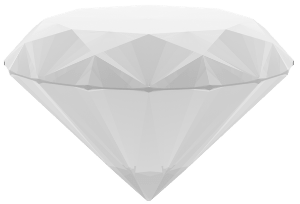Diamond


Diamond
Diamonds and their formation

Diamonds are associated with magical sparkle, flawless purity and high durability – but how
are these breathtakingly beautiful gemstones actually created? They are formed at depths of
150 to 300 kilometers below the earth’s surface. Only there are the extreme conditions required for their formation: temperatures of at least 1000 C° and very high pressure of 100 to 150 kilobar.
In this environment, in a slow process, pure carbon can become the fascinating gemstone, appreciated for its beauty, purity and transparency. As a rule, the formation of diamonds dates back over a billion years.
Properties of diamonds
The importance of these prerequisites becomes clear when one compares the diamond with the mineral graphite, which also consists only of carbon. The difference between the grey soft mineral and the hardest of all gemstones, which ideally shines in a bright white of perfect transparency, could not be greater.
It is not for nothing that the name diamond is derived from the Greek word αδάμας, adamantos (invincible, invulnerable). During the formation of diamonds, the carbon atoms combine in a regular crystal lattice and form their typical octahedane shape. The parent rock is usually kimberlite, less often also lamproite.
Diamond
The journey to the earth's surface

The natural treasures reach the earth's surface through volcanic activity. The parent rock of
the diamonds is transported upwards via penetration tubes (pipes) and accessible to humans. The chance of finding a diamond is still very low. The ratio of the gemstones to the parent rock is only one to one million.
Extraction is also tedious and time-consuming: tons of earth must be searched before a diamond is found. The rough diamonds also look completely inconspicuous. Only after they have been sanded and polished in a lengthy process can they shine in their full beauty.
Quality features – the diamond and its 4C
Of course, a large offer also brings with it many decision-making options – the four C's (4C)
are important factors as a guide.
‘What do you have to consider when buying diamonds?’ and ‘Which diamonds should you buy at all’ – these two questions can be easily answered using the following criteria:
• Cut• Carat ( carat (carat weight)• Colour (colour)• Clarity (clarity)
Diamond
CUT – the cut of the diamond

The cut is the most important criterion of the 4C. Unique symmetries and balanced proportions, not too flat and not too high – the precise facets of a diamond must be coherent in themselves.
This is the only way to ignite the extraordinary beauty and fire in the diamond that makes it so coveted.
CARAT – the weight of the diamond
Although most buyers are aware that diamonds are measured in the unit of measurement carat, what exactly does it tell us if a diamond has 1 carat, for example? Carat (abbreviation ct) is the unit in which the weight of a diamond is measured – one carat corresponds to 0.2 grams.
Basically: If all other factors are equivalent, diamonds with a higher carat number are more valuable than diamonds of lower weight.• The unit carat only indicates the weight, but not the size of the diamond. For example, a 2-carat diamond is not automatically twice the size of a one-carat diamond, although it is twice the weight.
Diamond
The colour of the diamond

Diamond
The clarity of the diamond

Every diamond is unique and rarely 'flawless' – that is, without inclusions. These so-called inclusions are natural impurities of the diamond and are classified on
